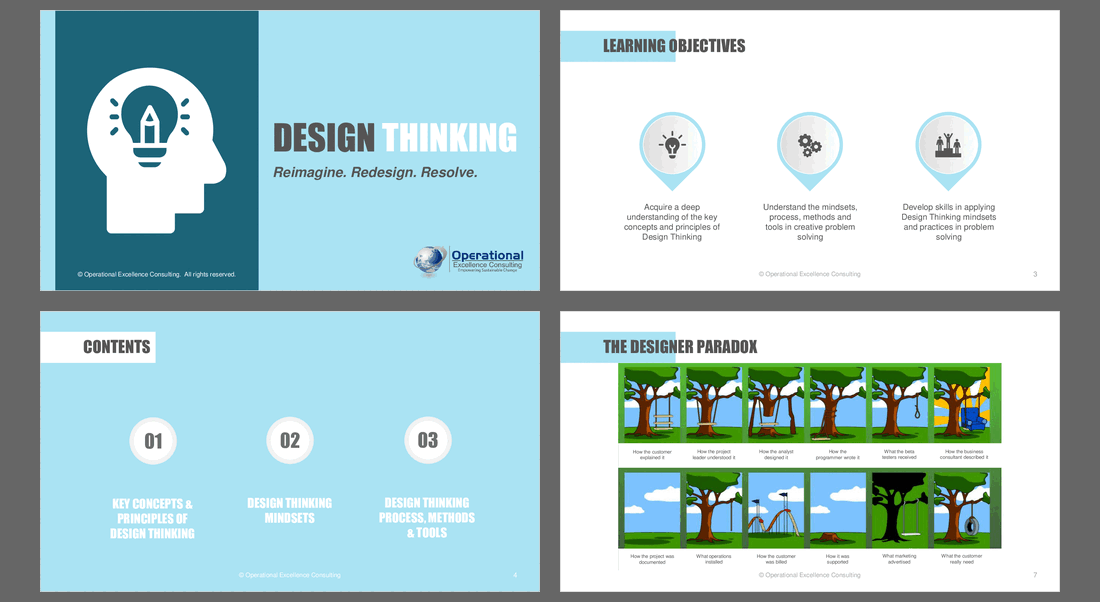Design Thinking (PowerPoint PPTX Slide Deck)
PowerPoint (PPTX) + supplemental PDF 225 Slides
BENEFITS OF THIS POWERPOINT DOCUMENT
- Provides a creative approach to innovation and problem solving based on the world-renowned Hasso Plattner Institute of Design (Stanford University) model.
- Provides a training and education tool to create awareness and kick-start your digital transformation process.
- Provides various ideation techniques to enhance employee creativity and outside-the-box thinking.
CUSTOMER EXPERIENCE PPT DESCRIPTION
[NOTE: Our Design Thinking presentation has been trusted by an array of prestigious organizations, including industry leaders such as Apple, MIT, NASA, Ford, Boeing, Fujitsu, Syngenta, Palo Alto Networks, and Mercer, to name just a few.]
Design Thinking is a process for creative problem solving. It allows everyone to use creative tools to address a vast range of challenges. The process is action-oriented, embraces simple mindset shifts and tackles problems from a new direction.
According to McKinsey, companies that adopt design as part of business practices can be more resilient than others—continuing to innovate, analyze, and strategize to solve complex problems during trying times.
Some of the world's leading brands, such as Apple, Nike, Starbucks and GE, have rapidly adopted the design thinking approach. What's more, design thinking is being taught at leading universities around the world, including Stanford, Harvard and MIT.
Based on the world-renowned Hasso Plattner Institute of Design at Stanford University (a.k.a. the "d.school") model, Design Thinking encourages organizations to focus on the people they are creating for, which leads to better products, services, and internal processes. The Design Thinking framework consists of five modes or phases: Empathize, Define, Ideate, Prototype and Test. The framework is fully compatible with Lean and Six Sigma approaches.
This comprehensive Design Thinking PPT training presentation is tailored specifically for Design Thinking facilitators, trainers, professionals and consultants who are preparing for delivery in a classroom or workshop environment. The included wallet design exercise could be replaced with your own design challenge. In addition, the introductory module can be used as a stand-alone awareness briefing material for a general audience.
You will get to train your target audiences how to solve problems creatively by building empathy, generating ideas, prototyping and testing new concepts before final implementation.
||||||||||||||||||||||||||||||||||||||||||||||||||||||||||||||||||||||||||||||||||||||||||||||||||||||||||||||||||||||||||||||||||||||||||||||||||||||
This training package includes:
1. Design Thinking PPT training presentation (PowerPoint format)
2. Design Thinking templates (PowerPoint format)
3. Wallet Design Exercise (Powerpoint format)
4. Design Thinking poster (PDF format, in color and monochrome, printable in A3 size)
||||||||||||||||||||||||||||||||||||||||||||||||||||||||||||||||||||||||||||||||||||||||||||||||||||||||||||||||||||||||||||||||||||||||||||||||||||||
LEARNING OBJECTIVES
1. Acquire a deep understanding of the key concepts and principles of Design Thinking.
2. Understand the mindsets, process, methods and tools in creative problem solving.
3. Develop skills in applying Design Thinking mindsets and practices in problem solving.
CONTENTS
1. Key Concepts and Principles of Design Thinking
• What is Design Thinking?
• What Design Thinking Is Not
• Benefits of Design Thinking
• Industrial Applications of Design Thinking
• Areas Within the Organization Where Design Thinking Can Apply
• The Framework of Design Thinking
• Case Studies of Design Thinking at Apple and Singapore Airlines
2. Mindsets of a Design Thinker
• Think Users First
• Ask the Right Questions
• Believe You Can Draw
• Commit to Explore
• Prototype to Test
3. Design Thinking Process, Methods and Tools
3.1 Empathize – Understand Your Customers/Users
• Empathy tools: User Feedback, Persona and Empathy Map
3.2 Define – Define Clear Project/Business Objectives
• Define tools: Point of View (POV), How Might We (HMW), Design Brief, Stakeholder Map, Context Map, Opportunity Map and Customer Journey Map
3.3 Ideate – Explore Ideas and Solutions
• Ideate methods/tools: Ideation Methods, Divergent Method, Convergent Method, Prioritization Map, Affinity Map and Ideas Evaluation Matrix
3.4 Prototype – Build and Visualize Ideas and Solutions
• Prototype tools: Physical Prototypes, Wireframes and Storyboards
3.5 Test – Review and Decide
• Test tools: User Feedback and Prototype Evaluation
Appendices
• Design Thinking Templates for Workshop Practice
• Wallet Design Project Worksheets
This presentation delves into the nuances of both divergent and convergent thinking, essential for effective problem-solving. It also highlights the importance of human-centered design, ensuring solutions are tailored to user needs.
Got a question about the product? Email us at support@flevy.com or ask the author directly by using the "Ask the Author a Question" form. If you cannot view the preview above this document description, go here to view the large preview instead.
Source: Best Practices in Customer Experience, Innovation Management, Service Design, Ideation PowerPoint Slides: Design Thinking PowerPoint (PPTX) Presentation Slide Deck, Operational Excellence Consulting
This document is available as part of the following discounted bundle(s):
Save %!
Design Thinking Consultant Toolkit
This bundle contains 3 total documents. See all the documents to the right.
Save %!
Value Innovation Toolkit
This bundle contains 2 total documents. See all the documents to the right.
Save %!
Business Model Design & Innovation Toolkit
This bundle contains 3 total documents. See all the documents to the right.
Save %!
Complete Service Design & Innovation Toolkit
This bundle contains 5 total documents. See all the documents to the right.









